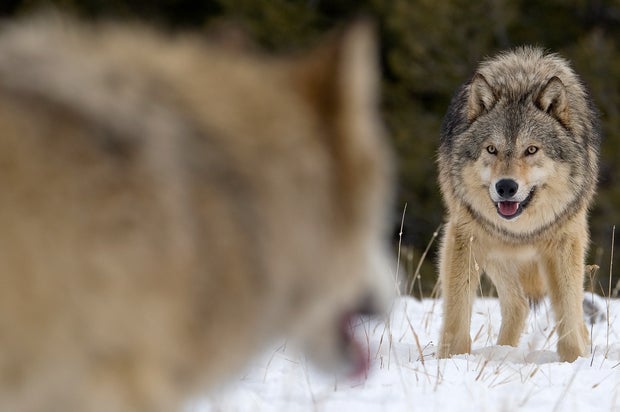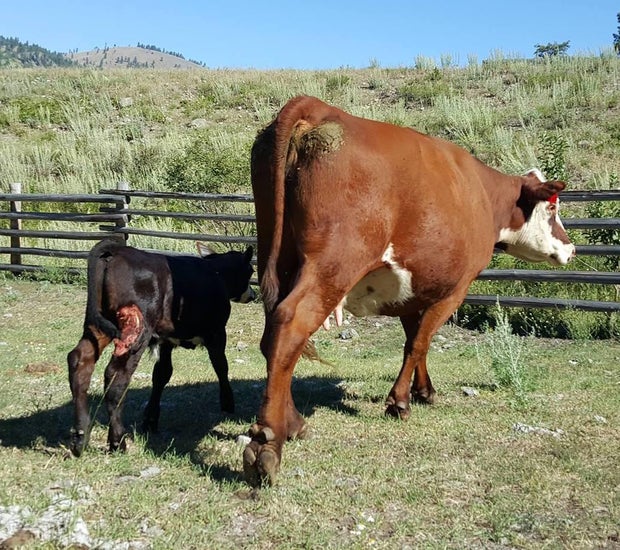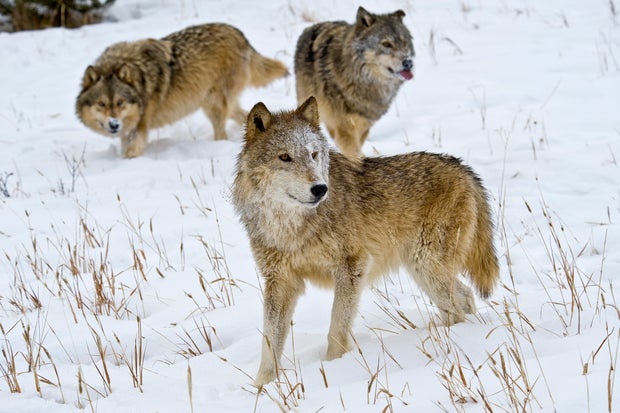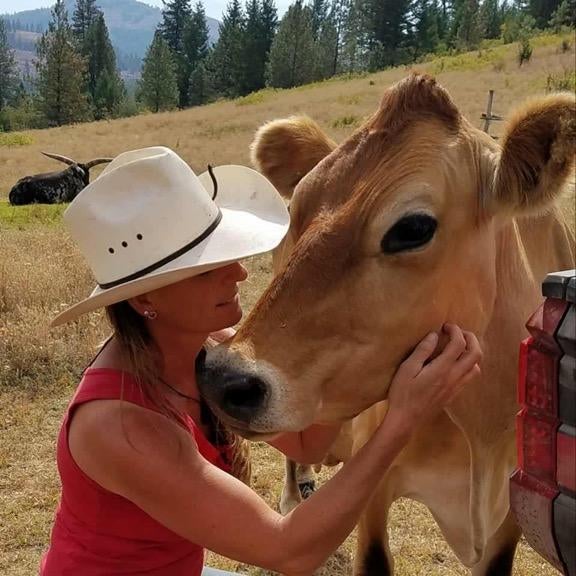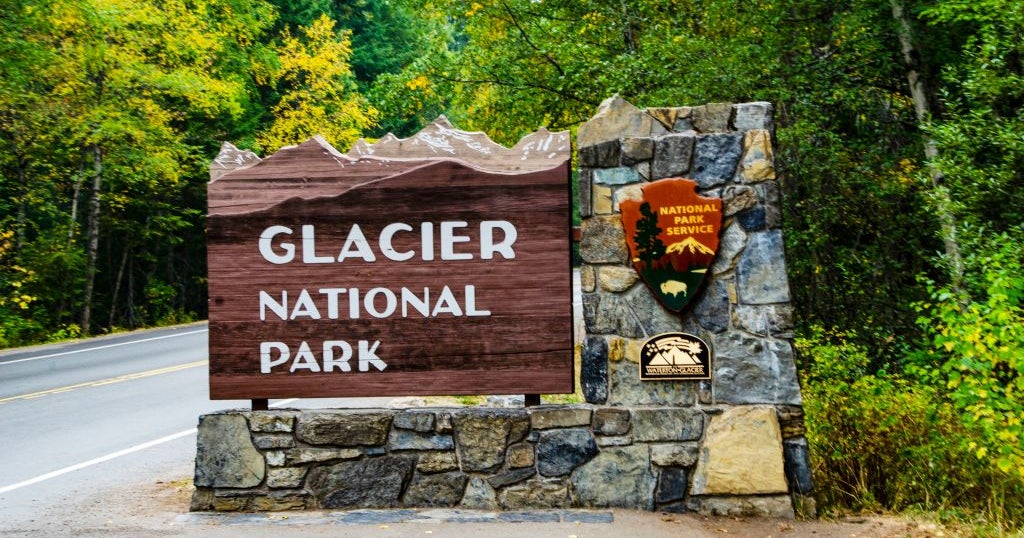CBS News
As gray wolves divide conservationists and ranchers, a mediator tries to tame all sides

When Francine Madden heard about a Wyoming man who killed a gray wolf after injuring it with his snowmobile and showing it off at his local bar, she was disturbed, but not very surprised.
She’s seen a lot during her almost three decades working as a mediator for wildlife conflict. She’s resolved disputes over gorillas in Uganda and tigers in Bhutan, but for 50-odd years, the management of gray wolves has been an intractable American problem.
Dennis Fast / VWPics/Universal Images Group via Getty Images
Since 1973, the gray wolf has been on and off the federal government’s endangered species list. When the wolves are on the list, advocates say the protections help wolves’ place in the natural environment and allow them to roam the great American West as they did for hundreds of years — not be treated, as some say, “like vermin.” On the other side, some ranchers then say there are too many wolves and they have to bear the economic — and emotional — costs of lost livestock.
“I watch my animals die and get murdered,” Kathy McKay, owner of the 1,600-acre K-Diamond-K ranch in Washington state, told CBS News. She says she can’t sleep at night in fear for the lives of her animals, and she’s lost about 40 to wolves.
When the wolves are off the endangered species list, as they are now in certain states in the lower 48, advocates say wolves are killed indiscriminately. Attorney and advocate Collette Adkins, carnivore conservation director at the Center for Biological Diversity, says wolf carcasses are “piling up” and there is a “cowboy mentality” around a species often not seen as worthy.
K-Diamond-K Guest Ranch
Enter Madden. Hired as a mediator by the federal government in December, this is her second time wading into the morass, albeit on a much larger scale. She facilitated Washington state’s 18-person working group on the gray wolves in 2015, helping to come to some policy decisions around population management.
Almost a decade later, she and her firm Constructive Conflict are back, this time at the national level. But in some ways, the sides have become more entrenched. Madden says she’s speaking to Americans who “feel their way of life, or what they care about, is under very real threat.” Yet she remains confident she’ll have all sides at the table starting in 2025.
Sides drawn along partisan lines
Thousands of gray wolves roamed America’s wilderness for centuries until hunters, ranchers and others nearly decimated the species. In 1973, the federal government listed them as endangered in the lower 48 states. Fewer than 1,000 wolves roamed in the U.S. at that time, according to the International Wolf Center.
Protected from hunting, gray wolves began to proliferate, and some people grew concerned they were killing livestock and threatening tribal communities and lands. Soon the pushback began.
Dennis Fast / VWPics/Universal Images Group via Getty Images
Animals were killed, businesses were shut, and the sides — often drawn along partisan lines — dug in, each convinced they knew the right approach to managing gray wolves. For many, “wolves became a symbol of government overreach,” said Adkins. Recent action sowed even more division; as the population rebounded, the gray wolf was taken off the federal government’s endangered species list in 2020 and the management was shifted to the states.
Wolves began to die. One example: a third of Wisconsin’s gray wolf population was killed by hunters and poachers when protections were removed, researchers at the University of Wisconsin found in 2021.
John Vucetich, a professor at Michigan Technological University, along with more than 100 other scientists, wrote to the Biden administration to reinstate protections. Lawsuits began, and on Feb. 10, 2022, gray wolves in the lower 48 states — with the exception of the Northern Rocky Mountain population — were added back to the list by a court order.
The news devastated McKay, who was born on the ranch her parents bought in 1961.
“I don’t know how people 300 miles away have so much control over our livelihood and the survival of our livestock,” said McKay. “Why do we even have to ask?”
K-Diamond-K Guest Ranch
Differing viewpoints, ongoing divisions
Working group members in Washington state couldn’t move any policy forward in the years before Madden arrived, she said, and they “couldn’t speak civilly or constructively to each other.”
“The costs of the conflict over wolves has been staggering,” she said, adding that no agency has truly been able to count the damage the economic costs — or societal costs — of the conflict.
“We weren’t that comfortable in the same room, with such differing viewpoints. Ranchers were carrying all of the burden, and there were environmentalists we felt didn’t have skin in the game,” said Washington rancher Molly Linville, a working group member whose husband’s family has worked 6,000 acres of land for more than 100 years.
In the year after Madden started mediating the local conflict, “they were able to come up with a decision they all agreed upon,” she said. At the end of a three-year, $1.2 million state contract, she said, the working group hammered out a series of constructive policies to manage wolves in their state.
Madden brings the same optimism to the national dialogue.
She’s close to the end of the first year of a three-year, $3 million contract. Her group contracted three companies to work on this project; one, a film company, will document the conversations around gray wolves and share the film with the public. Her group has already started selecting the roughly 24 participants who will have ongoing conversations on how to come together around gray wolves.
She traveled to Montana in June to meet with livestock producers and reservations and visit tribal nations. For the past year, she met with people from Wisconsin, Montana, California, Idaho, New Hampshire, North Carolina, Colorado, Maryland, Pennsylvania and Indiana. Madden acknowledges that “skepticism” abounds when she tells people her group’s approach to the conflict, but says many are open to talking as they feel that the “current vicious cycle of conflict in this country is harming people and wolves.”
She still believes in the power of Americans to listen to each other.
“There is a genuine hope that at a national scale, in this deeply divided society, we can come together for this conversation to take a step in the right direction for the long-term viability of communities, cultures and wildlife conservation,” said Madden.
CBS News
Boeing workers going on strike after overwhelming vote to reject contract offer and walk off the job

Seattle — Machinists at Boeing voted Thursday to go on strike, another setback for the giant aircraft maker whose reputation and finances have been battered and now faces a shutdown in production of its best-selling airline planes.
The International Association of Machinists and Aerospace Workers said its members rejected a contract that would have raised pay 25% over four years, then voted 94.6% to reject the contract and voted 96% to strike. A two-thirds vote among 33,000 workers was needed to strike.
“This is about respect, this is about the past, and this is about fighting for our future,” IAM District 751 President Jon Holden said in announcing the vote.
Very little has gone right for Boeing this year, from a panel blowing out and leaving a gaping hole in one of its passenger jets in January to NASA leaving two astronauts in space rather sending them home on a problem-plagued Boeing spacecraft.
As long as the strike lasts, it will deprive Boeing of much-needed cash that it gets from delivering new planes to airlines. That will be another challenge for new CEO Kelly Ortberg, who six weeks ago was given the job of turning around a company that has lost more than $25 billion in the last six years and fallen behind European rival Airbus.
Ortberg warned machinists that a strike vote would put Boeing’s recovery in jeopardy and raise more doubt about the company in the eyes of its airline customers.
Workers were in no mood to listen.
Ortberg made a last-ditch effort to avert a strike, telling machinists Wednesday that “no one wins” in a walkout.
“For Boeing, it is no secret that our business is in a difficult period, in part due to our own mistakes in the past,” he said. “Working together, I know that we can get back on track, but a strike would put our shared recovery in jeopardy, further eroding trust with our customers and hurting our ability to determine our future together.”
Many union members have posted complaints about the deal all week on social media. On Thursday, several dozen blew whistles, banged drums and held up signs calling for a strike as they marched to a union hall near Boeing’s 737 Max plant in Renton, Washington.
“As you can see, the solidarity is here,” said Chase Sparkman, a quality-assurance worker. “I’m expecting my union brothers and sisters to stand shoulder to shoulder, arm in arm, and let our company know that, hey, we deserve more.”
The machinists make $75,608 per year on average, not counting overtime, and that would rise to $106,350 at the end of the four-year contract, according to Boeing.
However, the deal fell short of the union’s initial demand for pay raises of 40% over three years. The union also wanted to restore traditional pensions that were axed a decade ago but settled for an increase in Boeing contributions to employee’s 401(k) retirement accounts.
Although the bargaining committee that negotiated the contract recommended ratification, Holden predicted earlier this week that workers would vote to strike.
Boeing worker Adam Vogel called the 25% raise “a load of crap. We haven’t had a raise in 16 years.”
Broderick Conway, another quality-assurance worker and 16-year Boeing employee, said the company can afford more.
“A lot of the members are pretty upset about our first offer. We’re hoping that the second offer is what we’re looking for,” he said. “If not … we’re going to keep striking and stand up for ourselves.”
The head of Boeing’s commercial-airplanes business, Stephanie Pope, tried earlier this week to discourage workers from thinking a strike would result in a better offer.
“We bargained in absolute good faith with the IAM team that represents you and your interests,” she said. “Let me be clear: We did not hold back with an eye on a second vote.”
Voting began at 5 a.m. local time at union halls in Washington state, Portland, Oregon, and a smattering of other locations.
A strike would stop production of the 737 Max, the company’s best-selling airliner, along with the 777 or “triple-seven” jet and the 767 cargo plane at factories in Everett and Renton, Washington, near Seattle. It likely would not affect Boeing 787 Dreamliners, which are built by nonunion workers in South Carolina.
TD Cowen aerospace analyst Cai von Rumohr said it is realistic based on the history of strikes at Boeing to figure that a walkout would last into mid-November, when workers’ $150 weekly payments from the union’s strike fund might seem low going into the holidays.
A strike that long would cost Boeing up to $3.5 billion in cash flow because the company gets about 60% of the sale price when it delivers a plane to the buyer, von Rumohr said.
Union negotiators unanimously recommended that workers approve the tentative contract reached over the weekend.
Boeing promised to build its next new plane in the Puget Sound area. That plane – not expected until sometime in the 2030s – would replace the 737 Max. That was a key win for union leaders, who want to avoid a repeat of Boeing moving production of Dreamliners from Everett to South Carolina.
Holden told members Monday the union got everything it could in bargaining and recommended approval of the deal “because we can’t guarantee we can achieve more in a strike.”
Many union members, however, are still bitter about previous concessions on pensions, health care and pay.
“They are upset. They have a lot of things they want. I think Boeing understands that and wants to satisfy a fair number of them,” said von Rumohr, the aerospace analyst. “The question is, are they going to do enough?”
Boeing has seen its reputation battered since two 737 Max airliners crashed in 2018 and 2019, killing 346 people. The safety of its products came under renewed scrutiny after a panel blew out of a Max during a flight in January.
___
Koenig reported from Dallas.
(Copyright 2024 The Associated Press. All rights reserved. This material may not be published, broadcast, rewritten or redistributed without permission.)
9/13/2024 12:43:48 AM (GMT -4:00)
CBS News
9/12: CBS Evening News – CBS News

Watch CBS News
Be the first to know
Get browser notifications for breaking news, live events, and exclusive reporting.
CBS News
Miami Dolphins QB Tua Tagovailoa leaves field with concussion after collision with Bills’ Damar Hamlin
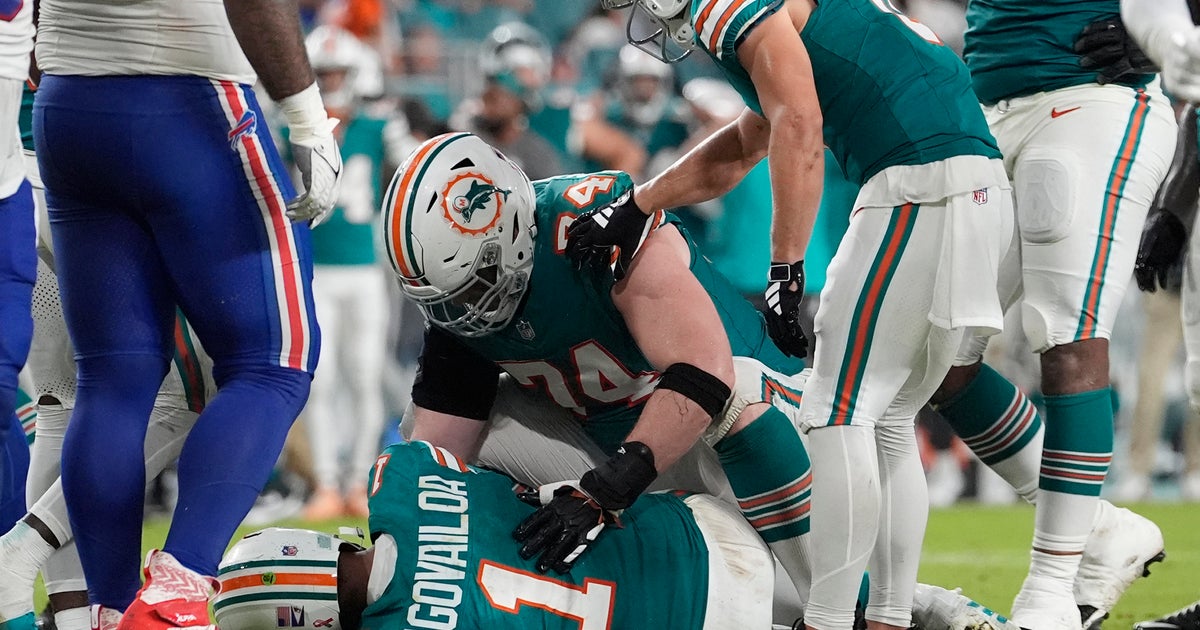
Miami Dolphins quarterback Tua Tagovailoa was ruled out of Thursday night’s game with the Buffalo Bills because of a concussion after colliding with defensive back Damar Hamlin and hitting the back of his head against the turf.
Tagovailoa, who has a history of dealing with head injuries, remained down for about two minutes before getting to his feet and walking to the sideline after the play in the third quarter. He made his way to the tunnel not long afterward, looking into the stands, appeared to smile and departed for the locker room.
Lynne Sladky / AP
The Dolphins needed almost no time before announcing it was a concussion.
Tagovailoa, who sustained multiple concussions his first three NFL seasons, positioned himself for a big pay bump with an injury-free and productive 2023. He threw for 29 touchdowns and a league-best 4,624 yards.
He signed a four-year, $212 million extension before this season and was the NFL’s leading passer in Week 1 this season. Tagovailoa left the game with the Dolphins trailing 31-10, which held as the final score.
Tagovailoa was hurt on a fourth-down keeper with about 4:30 left in the third. He went straight ahead into Hamlin and did not slide, leading with his right shoulder instead.
He wound up on his back, both his hands in the air and Bills players immediately pointed at Tagovailoa as if to suggest there was an injury. Dolphins center Aaron Brewer quickly did the same, waving to the sideline.
Tagovailoa eventually got to his feet. Dolphins coach Mike McDaniel grabbed the side of his quarterback’s head and gave him a kiss on the cheek as Tagovailoa departed. Skylar Thompson came into the game to take Tagovailoa’s spot.
Hamlin was the player who suffered a cardiac arrest after making a tackle during a Monday night game in January 2023 at Cincinnati, causing the NFL to suspend a pivotal game that quickly lost significance in the aftermath of a scary scene that unfolded in front of a national television audience.
Tagovailoa’s history with concussions — and how he has since worked to avoid them — is a huge part of the story of his career, and now comes to the forefront once again.
He had at least two concussions during the 2022 season. He was hurt in a Week 3 game against Buffalo and cleared concussion protocol, though he appeared disoriented on that play but returned to the game.
The NFL later changed its concussion protocol to mandate that if a player shows possible concussion symptoms — including a lack of balance or stability — he must sit out the rest of the game.
Less than a week later, in a Thursday night game at Cincinnati, Tagovailoa was concussed on a scary hit that briefly knocked him unconscious and led to him being taken off the field on a stretcher.
His second known concussion of that season came in a December game against Green Bay, and he didn’t play for the rest of the 2022 season.
Going into last season, Tagovailoa added muscle and spent time studying jiu-jitsu in an effort to learn how to fall more safely and try to protect himself against further injury.


